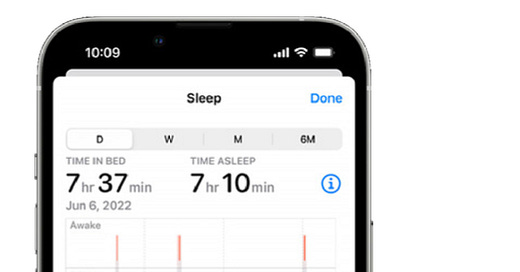The Rise of the Apple Watch
Few devices have reshaped the wearables market like the Apple Watch. Launched in 2015, it has grown into a multi-billion-dollar product line with over 100 million users worldwide.
The Excitement Around Sleep Tracking
When Apple added sleep stage tracking in 2022, it generated significant excitement. Soon, patients were showing up in our clinics concerned about the amount of ‘deep sleep’ and REM they were getting, as these are linked to restorative rest. The line between these gadgets and medical-grade devices continues to blur— Apple announced in September 2024 that its watches received FDA clearance to notify wearers of potential sleep apnea, (which we discuss in detail in our OSA 101 series). But does the technology behind these features truly deliver?
Technology Behind Apple Watch Sleep Tracking
Apple Watch uses a combination of sensors to monitor sleep:
Accelerometer: Tracks movement to suggest when you’re asleep and awake. This can also provide some information of oscillating breathing pattern and disturbed breathing.
Optical Heart Rate Sensor: Monitors heart rate variability to estimate time spent in different sleep stages, such as REM and deep sleep.
Machine Learning Algorithms: Analyzes patterns in the data to provide an overall sleep picture.
While these technologies are worthwhile surrogates, they’re still indirect measures of sleep. Full sleep staging requires polysomnography (PSG) - a controlled environment where patients are evaluated with brain monitoring (EEG) amongst other measures to determine time in each stage, as well as disturbances during sleep.
What Does the Science Say?
Several studies have evaluated the accuracy of wearable sleep trackers, including the Apple Watch. The consensus? While it does well in estimating sleep duration, its accuracy in identifying sleep stages like REM or deep sleep remains imperfect. According to a 2022 study, the Apple Watch had moderate agreement with PSG sleep times, but struggled in distinguishing between sleep stages. This is consistent with Apple’s own internal data showing good sensitivity for identifying sleep/wake, but less success in sleep staging (see below).
The Verdict
In my (CG) clinical experience, some patients find good alignment with their sleep quality and Apple Watch data (and other wearables, like Oura ring) - while others see significant discrepancies. Similarly, I have seen wildly varying watch tracking vs. sleep study results. While Apple Watch offers an accessible and useful way to track sleep, it shouldn't replace clinical sleep evaluations by physicians and formal testing.
Closing Thoughts
We agree that being proactive in sleep health is worthwhile, and wearables certainly have enhanced awareness of individual sleep. With that said, there’s an emerging trend of sleep SCORES optimization/fixation causing MORE distress and poor sleep amongst patients, termed orthosomnia. We should focus on using data to learn and improve habits conducive to better sleep not to lose our sleep over a sleep score below 80. We look forward to exploring science-based tips and tools to enhance sleep, and also quieting the noise on the myriad sleep information that is contributing to this phenomena. If your wearable is showing concern regarding your sleep, especially if you have symptoms, it is worth discussing with a sleep specialist for further evaluation.
What’s been your experience with sleep wearables? Feel free to comment below.
What wearable has the best data to support its use? Subscribe to our newsletter to find that out and more.
Disclosure: RC participates in industry sponsored studies related to wearables.








im a bipap user, wishing oximetry data produced by the mainstream devices to be of high enough quality to analyze O2 fluctuations around apnea events - it feels a capability within reach
I took my Oura Ring into my psg 2 years ago and the only accurate data was rem sleep. Nothing else was even remotely accurate